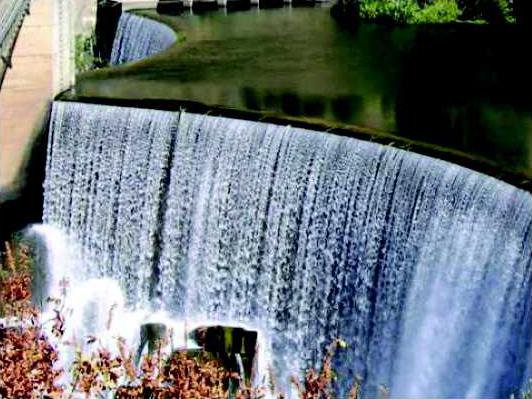Nestled in the rustic Stanislaus River canyon below the western horizon from busy Highway 108-120 in the bottomland of Tuolumne County is arguably the most critical chunk of concrete ever poured when it comes to powering the Manteca economy.
It is here some 35 miles to the northeast of Manteca you’ll find Goodwin Dam. The 400-foot high dam was completed in December of 1912 as a storage and diversion point for the South San Joaquin Irrigation District and its 108-year-old partner – the Oakdale Irrigation District.
The SSJID share was $342,500 – $18,300 less than the median price of a resale home closing escrow in Manteca today.
Goodwin Dam was the first part of the SSJID system constructed after voters authorized the formation of the district on May 11, 1909 as well as authorized the issuance of $1,875,000 in bonds. The vote was 396 to 67.
The dam site is two and a half miles above Knights Ferry on the river. It was named for the first president of the SSJID governing board – Benjamin A. Goodwin.
The dedication of Goodwin Dam on April 6, 1913 featured California’s famous reform governor Hirman Johnson opening the head gate. He delivered the dedication speech to a crowd newspapers at the time estimated at well over 4,000 people.
One newspaper – the Manteca Enterprise – inventoried the picnic grounds near the dam that day and counted 927 autos, 107 motorcycles, and over 100 buggies.
Goodwin Dam’s
completion triggered
economic development
in Manteca area
Completion of the dam touched off a flurry of economic activity in and around Manteca.
The area — known in California agricultural circles at the time as “the Great Alfalfa Region” — was gearing up for a farming transformation. Surface irrigation water was destined to make Manteca a premier tomato growing region in a few years and one of the nation’s largest producers of watermelons.
It also would spur a growing number of orchards with almonds and peaches leading the way.
Given secured water was considered better than striking gold, Goodwin Dam’s completion prompted railroads to offer “home seekers” a chance to visit and look over the land before settling Manteca with round trip tickets as low as $55 from New York, $33 from Chicago and $25 from Omaha.
That was according to the premier edition January 1913 edition of the Development News magazine “containing interesting facts about the great South San Joaquin Irrigation District”.
Besides boasting about Manteca’s ideal location to reach markets in San Francisco, Oakland, and Sacramento, the magazine featured a photo of the new $125,000 and 5,000-kilowatt capacity sub-station of the Sierra & San Francisco Power Co. that was eventually bought by PG&E. The photo showed the sub-station (where the PG&E substation is now located on Elm Avenue near the skate park) with a train pulled by a steam locomotive passing by and nothing but one farmhouse on the western horizon roughly where the golf course is today.
Ads offered alfalfa lands for $80 to $300 per acre.
There were various photos to the homes of “prosperous farmers” throughout the magazine that sold for a nickel per copy or 25 cents a years. There was also a photograph of two large tents with the caption underneath reading, “Climatic conditions are such that this family lived in tents all last winter.”
Goodwin Dam work
followed by other
SSJID improvements
As soon as work was completed on the Goodwin Dam. the SSJID started the next phase of 300 miles of tunnels and ditches to bring water to the Manteca-Ripon-Escalon area.
It included a 2,000-foot long wooden flume carrying water 68 feet in the air bridging a major depression some six miles south of Knights Ferry.
Two giant dry land dredges worked 20 hours a day digging the main canal. Four months after Goodwin Dam was completed, water started rushing through the ditches.
The first water released was on Aug. 13, 1913 to the E.N. Pierce Ranch on the southeast corner of Austin Road and Highway 120 where Calla High stands today.
Spring of 1914 was the first season for full water deliveries.
Manteca went from 15,539 acres under cultivation to 51,095 acres of farm production almost overnight. The South County’s growth mirrored the increased farmland production irrigation water made possible as the population soared from 3,000 in the years prior to the dam being built to over 15,000 once water was flowing.
The next phase was building Woodward Reservoir that provided 36,000 acre feet of in-district storage. That reservoir some 16 miles northeast of Manteca was completed in 1916.
The SSJID tried to float a bond for a component board members thought was critical for the long-range economic health of South County farming – the Melones Dam. Voters rejected the bond. It wasn’t until the drought of 1924 that public opinion changed. Bonds for Melones Dam were passed that year clearing the way for the dam’s dedication on Nov. 11, 1926.
An agreement with the Bureau of Reclamation allowed the Melones Dam operated jointly by SSJID and OID to be replaced by the New Melones Reservoir that was completed in 1979 creating some 2.4 million acre feet of storage on the Stanislaus River. A large chunk of the two district’s water supply is factored into the inflow into New Melones that acknowledges the original water rights of the two agencies.
For more information, e-mail swyatt@mantecabulletin.com
The good times start
Goodwin Dam led to Mantecas economic growth





